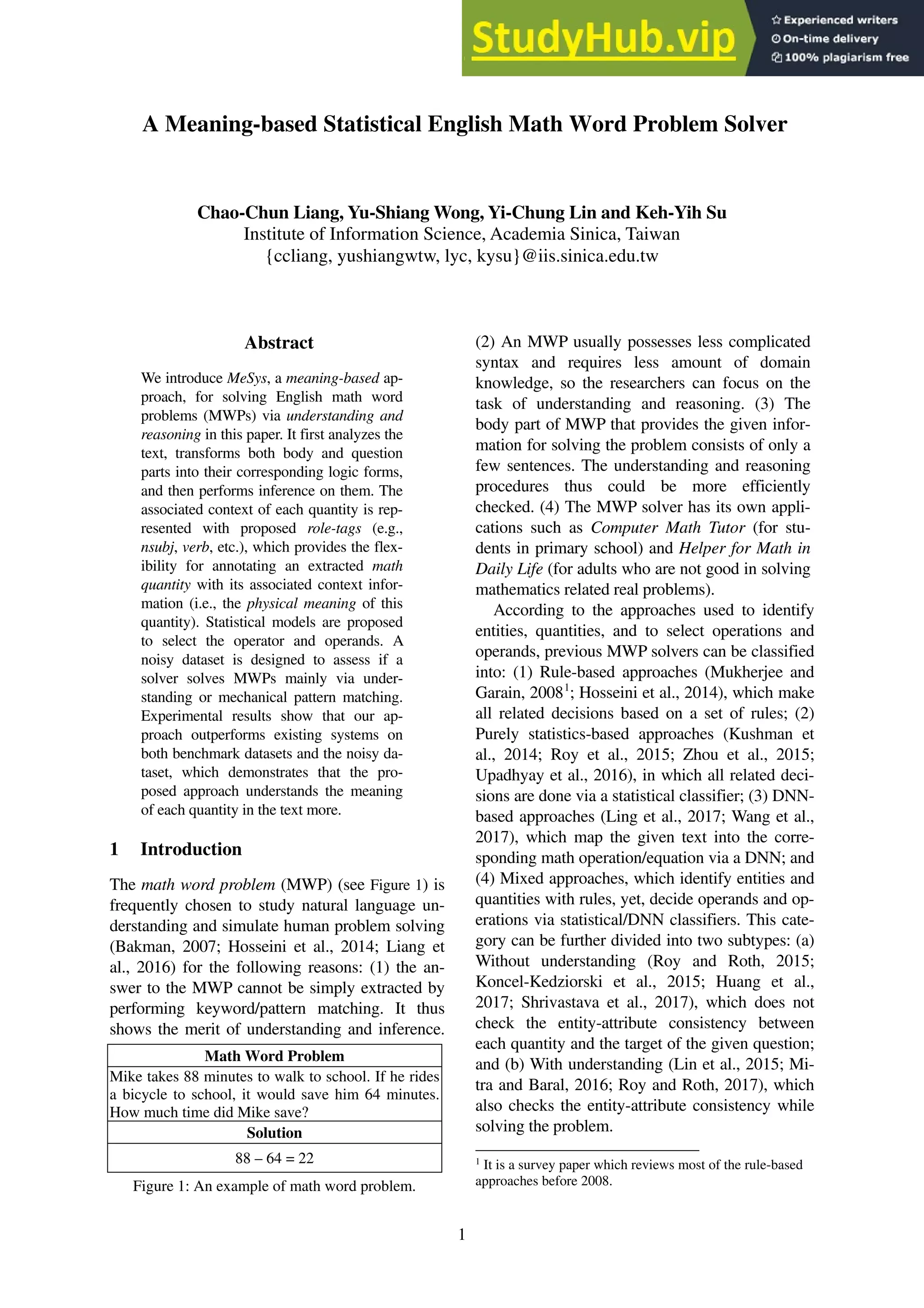This document summarizes a research paper that introduces MeSys, a meaning-based approach for solving English math word problems. MeSys first analyzes text to transform the body and question into logic forms, then performs inference to solve problems. It outperforms existing systems by understanding the meaning of each quantity rather than just pattern matching. The researchers created a noisy dataset to test if systems truly understand problems or just match patterns.




![5
the last line in Figure 4(b), three newly derived
quantity facts q4, q5 and q6 (in 4(d)) can be uni-
fied with the first argument quan(?q,dollar,#) in
4(c), but only q4 and q5 satisfy the second ar-
gument verb(?q,pay)&nsubj(?q,Tim). As a result,
the answer 2.5 is returned by taking sum on the
values of the quantity facts quan(q4,dollar,#) and
quan(q5,dollar,#).
2.4 Probabilistic Operand Selection
The most error-prone part in the LFT module is
instantiating the utility function of math operation
especially if many irrelevant quantity facts appear
in the given MWP. Figure 5 shows the LFT mod-
ule needs to select two quantity facts (among 4)
for Addition. Please note that the question quantity
qQ, transformed from “how many flowers”, is not a
candidate for operand selection.
Lin et al., (2015) used predefined lexico-
syntactic patterns and ad-hoc rules to instantiate
utility functions. However, their rule-based ap-
proach fails when the MWP involves more quanti-
ties. Therefore, we propose a statistical model to
select operands for the utility functions Addition,
Subtraction, Multiplication and Division. The op-
erand selection procedure can be regarded as find-
ing the most likely configuration (𝑜𝑜1
𝑛𝑛
, 𝑟𝑟), where
𝑜𝑜1
𝑛𝑛
= 𝑜𝑜1, ⋯ , 𝑜𝑜𝑛𝑛 is a sequence of random indica-
tors which denote if the corresponding quantity
will be selected as an operand, and 𝑟𝑟 is a tri-state
variable to represent the relation between the val-
ues of two operands (i.e., 𝑟𝑟 = −1, 0 or 1 ; which
denote that the first operand is less than, equal to,
or greater than the second operand, respectively).
Given a solution type 𝑠𝑠, the MWP logic expres-
sions 𝕃𝕃 and the 𝑛𝑛 quantities 𝑞𝑞1
𝑛𝑛
= 𝑞𝑞1, ⋯ , 𝑞𝑞𝑛𝑛 in 𝕃𝕃.
The procedure is formulated as:
𝑃𝑃(𝑟𝑟, 𝑜𝑜1
𝑛𝑛|𝑞𝑞1
𝑛𝑛
, 𝕃𝕃, 𝑠𝑠) ≈ 𝑃𝑃(𝑟𝑟|𝑠𝑠) × 𝑃𝑃(𝑜𝑜1
𝑛𝑛|𝑞𝑞1
𝑛𝑛
, 𝕃𝕃, 𝑠𝑠), (1)
𝑃𝑃(𝑟𝑟|𝑠𝑠) simply refers to Relative Frequency (as it
has only a few parameters and we have enough
training samples). 𝑃𝑃(𝑜𝑜1
𝑛𝑛|𝑞𝑞1
𝑛𝑛
, 𝕃𝕃, 𝑠𝑠) is further de-
rived as:
𝑃𝑃(𝑜𝑜1
𝑛𝑛|𝑞𝑞1
𝑛𝑛
, 𝕃𝕃, 𝑠𝑠)
≈ ∏ 𝑃𝑃(𝑜𝑜𝑖𝑖|𝑞𝑞𝑖𝑖, 𝕃𝕃, 𝑠𝑠)
𝑛𝑛
𝑖𝑖=1 ≈ ∏ 𝑃𝑃�𝑜𝑜𝑖𝑖�Φ(𝑞𝑞𝑖𝑖, 𝕃𝕃, 𝑠𝑠)�,
𝑛𝑛
𝑖𝑖=1
(2)
where Φ(∙) is a feature extraction function to map
𝑞𝑞𝑖𝑖 and its context into a feature vector. Here, the
probabilistic factor 𝑃𝑃�𝑜𝑜𝑖𝑖�Φ(𝑞𝑞𝑖𝑖, 𝕃𝕃, 𝑠𝑠)� is obtained
via an SVM classifier (Chang and Lin, 2011).
Φ(∙) extracts total 25 features (specified as fol-
lows, and 24 of them are binary) for 𝑞𝑞𝑖𝑖. The fol-
lowing 11 of them are independent on the ques-
tion in the MWP:
1. Four features to indicate if 𝑠𝑠 is Addition, Sub-
traction, Multiplication or Division.
2. A feature to indicate if 𝑞𝑞𝑖𝑖 is within a
qmap(…).
3. A feature to indicate if 𝑞𝑞𝑖𝑖 = 1.
4. Five features to indicate if 𝑛𝑛 < 2, 𝑛𝑛 = 2, 𝑛𝑛 =
3, 𝑛𝑛 = 4 or 𝑛𝑛 > 4; where 𝑛𝑛 is the number of
quantities in Eq (1).
Φ(∙) also extracts features by matching the logic
expressions of 𝑞𝑞𝑖𝑖 with those of question quantity
qQ to check the role-tag consistencies between 𝑞𝑞𝑖𝑖
and qQ. Another fourteen features are extracted
with three indicator functions 𝐼𝐼𝑚𝑚(⋅), 𝐼𝐼𝑒𝑒(⋅),
𝐼𝐼∃(⋅) and one tri-state function 𝑇𝑇𝑚𝑚(⋅) as follows:
[ 𝐼𝐼𝑚𝑚(𝑞𝑞𝑖𝑖, qQ, entity), 𝐼𝐼𝑒𝑒(𝑞𝑞𝑖𝑖, qQ, entity),
𝐼𝐼𝑚𝑚(𝑞𝑞𝑖𝑖, qQ, verb), 𝐼𝐼𝑒𝑒(𝑞𝑞𝑖𝑖, qQ, verb),
𝐼𝐼∃(qQ, nsubj), 𝑇𝑇𝑚𝑚(𝑞𝑞𝑖𝑖, qQ, nsubj),
𝐼𝐼∃(qQ, modifier), 𝐼𝐼𝑚𝑚(𝑞𝑞𝑖𝑖, qQ, modifier),
𝐼𝐼∃(qQ, place), 𝐼𝐼𝑚𝑚(𝑞𝑞𝑖𝑖, qQ, place),
𝐼𝐼∃(qQ, temporal), 𝐼𝐼𝑚𝑚(𝑞𝑞𝑖𝑖, qQ, temporal),
𝐼𝐼∃(qQ, xcomp), 𝐼𝐼𝑚𝑚(𝑞𝑞𝑖𝑖, qQ, xcomp) ]
where the indicator functions 𝐼𝐼𝑚𝑚(𝑥𝑥, 𝑦𝑦, 𝑧𝑧) checks if
the 𝑧𝑧 of 𝑥𝑥 matches the 𝑧𝑧 of 𝑦𝑦, 𝐼𝐼𝑒𝑒(𝑥𝑥, 𝑦𝑦, 𝑧𝑧) checks if
the 𝑧𝑧 of 𝑥𝑥 entails the 𝑧𝑧 of 𝑦𝑦 and 𝐼𝐼∃(𝑦𝑦, 𝑧𝑧) checks if
the 𝑧𝑧 of 𝑦𝑦 exists. 𝑇𝑇𝑚𝑚(𝑞𝑞𝑖𝑖, qQ, nsubj) returns “exact-
match” (if nsubj of 𝑞𝑞𝑖𝑖 matches nsubj of qQ ),
“quasi-match” (if nsubj of qQ does not exist or is a
plural pronoun), and “unmatch”.
𝐼𝐼𝑒𝑒(⋅) uses the WordNet hypernym and
hyponym relationship to judge whether one
entity/verb entails another one or not via checking
if they are in an inherited hypernym-path in
WordNet. The entity, verb and nsubj of a quantity
are determined according to the logic expressions.
The modifier, place, temporal and xcomp of a
quantity are extracted from the dependency tree
with some lexico-syntactic patterns. For example,
the modifier and place of the quantity in the
sentence “There are 30 red flowers in the garden.”
are “red” and “garden” respectively. The temporal
(a) Tim bought 2 roses and 3 lilies. Mary bought 4 roses
and 5 lilies. How many flowers did Tim buy?
(b) quan(q1,#,rose)=2&verb(q1,buy)&nsubj(q1,Tim)…
quan(q2,#,lily)=3&verb(q2,buy)&nsubj(q2,Tim)…
quan(q3,#,rose)=4&verb(q3,buy)&nsubj(q3,Mary)…
quan(q4,#,lily)=5&verb(q4,buy)&nsubj(q4,Mary)…
quan(qQ,#,flower)&verb(qQ,buy)&nsubj(qQ,Tim)…
Figure 5: An example for operand selection](https://image.slidesharecdn.com/ameaning-basedstatisticalenglishmathwordproblemsolver-230807180147-ef833eef/75/A-Meaning-Based-Statistical-English-Math-Word-Problem-Solver-pdf-5-2048.jpg)





